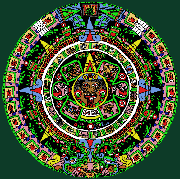A
SIMPLE GUIDE TO PRONOUNCING MEXICAN PLACE NAMES
by
Bob Brooke
  Even
though Mexico was long ago conquered by the Spanish, as was much of
Latin America, the names of its towns and cities are, in many cases,
derived from names given them by the indigenous people who lived there
long before the conquest. Some places have retained their original
names, while others are a combination of Spanish saint's names and their
indigenous counterpart. And others have been renamed for revolutionary
heros, such as San Miguel de Allende, named for the town's patron saint
and Ignacio de Allende, one of the leaders in Mexico's fight for
independence from Spain. Even
though Mexico was long ago conquered by the Spanish, as was much of
Latin America, the names of its towns and cities are, in many cases,
derived from names given them by the indigenous people who lived there
long before the conquest. Some places have retained their original
names, while others are a combination of Spanish saint's names and their
indigenous counterpart. And others have been renamed for revolutionary
heros, such as San Miguel de Allende, named for the town's patron saint
and Ignacio de Allende, one of the leaders in Mexico's fight for
independence from Spain.
The Spanish missionaries
had a hard time pronouncing many of the Aztec words. The Aztecs spoke
Nahuatl, a language filled with strange letter combinations.
Particularly difficult were the unique combinations of consonants.
These missionaries found
that there were sounds produced in Nahuatl that didn't exist in
Castillian Spanish. So they replaced whatever characters they couldn't
pronounce with an x. Usually, the x stood for an sh
sound. They eventually replaced the sh pronunciation with the
easier ch or even simply an s, so that Nahuatl word for
flower becomes xo'chitl. Today, Mexicans pronounce Xochimilco,
known for its floating gardens and meaning "plantation of
flowers," as so-chee-meel-koh.
Another example of a case
where the sh sound has been replaced by and s sound but
the actual visible letter is x is Tlaxcala (in the original
language of the Tlaxcallans, pronounced Tlash-Kall-ahns), meaning
"residence (or, place) of bread (or tortillas). Spanish-speaking
Mexicans now pronounce the name of both the state and city of Tlaxcala
as Tlass-kall-ah. But, unfortunately, this hasn't occurred
universally. For instance, Chignahuapan is a case where sh sound
has been replaced by ch in both letters and sound. Residents fo
the small community of Xonaca, just outside the city of Puebla,
pronounce their town's name as shoh-nah-kah (from the original Xonocatl,
meaning onion in Nahuatl), with the x representing an sh
sound.
The Spanish missionaries
also had trouble pronouncing the Aztec or Nahuatl "t." The
closest they came to writing this sound was to use a T followed
by an L. This sound is composed of two separate sounds-the sound
of the letter "T" and the sound of the letter
"L"--and is quite different from the single sound of the
letter "T."
An example where an
initial x became j is in the name of the city of Jalapa in
the State of Veracruz. Natives of the region write it as Xalapa. But
originally it was Xalapan, pronounced Shah-llah-pahn, meaning "sand
upon the waters." By the way, this is where the jalapeño pepper
got its name.
Certain suffixes are very
common in Mexican place names of Nahuatl origin. One of the most common
is -tlan, which means "place near an abundance of..."
For instance, Mazatlan, a resort on Mexico's Pacific coast, means
"place near an abundance of deer"(mazatl). Tepotzotlán,
in the State of Mexico, means "place of the hunchback.".
The suffix -co, as in
Acapulco, means "place of thick reeds." Atotonilco, a small
town with natural hot springs in the State of Morelos, means "place
of heated water," while the suffix -tepec means "hilly
place." Chapultepec Park in Mexico City, means "hilly place of
grasshoppers," while Coatepec, a small town in the State of
Veracruz, means "hilly place of snakes," and Tehuantepec, in
the State of Oaxaca, means "hill of the jaguar."
Other suffixes like -pan
(on) and -can (place) added to Nahuatl words like coyotl,
creating Coyocan, or "place of coyotes," and Uruapan, or
"where flowers bloom."
In the States of Yucatan,
Chiapas and Campeche, many of the place names are Maya. Bonampak, for
example, means "painted walls," since this Maya site is known
for its frescoes. Izamal, or "city of hills" in Maya, is a
charming little town on the Yucatan peninsula. Other towns and villages
have retained their native Tarascan names, such as Tzintzuntzan, or
"place of the hummingbirds" (pronounced, zin-zoon-zan)
in the State of Michoacan.
The Conquistadores named
a good number of cities and towns after their home towns in Spain, such
as Cordoba and Salamanca, and others after viceroys and counts, like
Monterrey and San Miguel Regla.
With a little practice,
anyone can pronounce Mexican place names easily.
To read more articles by
Bob Brooke, please visit his Web
site. |

